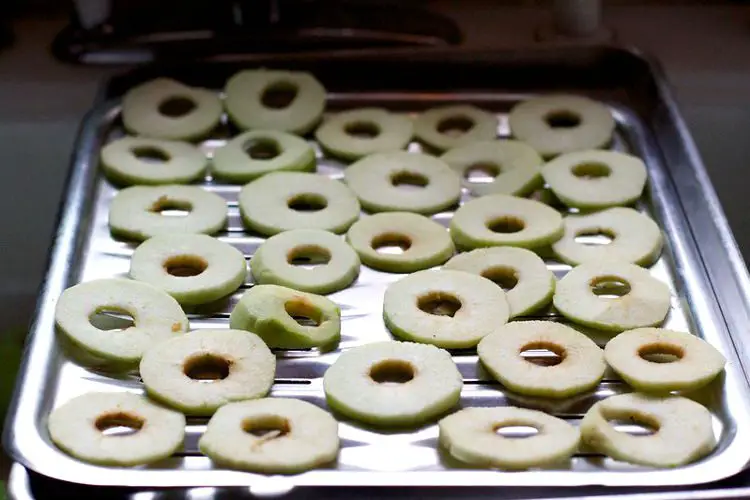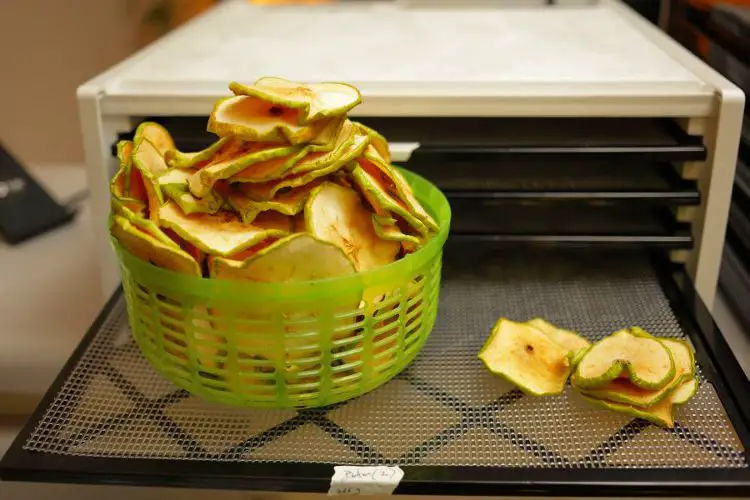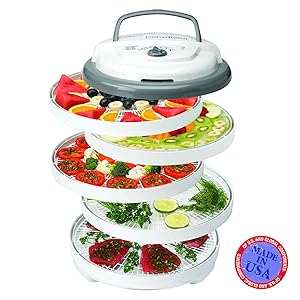SHTFPreparedness may collect a share of sales or other compensation from the links on this page.
When it comes to dehydrated fruits, apples are absolutely delicious. They can also be rehydrated and used in all sorts of recipes. Do you know how to dehydrate apples?
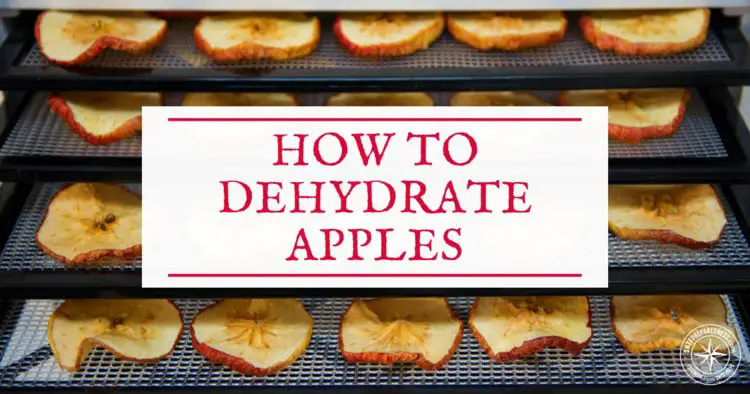 Is there a fruit more woven into our culture than the apple?
Is there a fruit more woven into our culture than the apple?
Eve is depicted with an apple in her hand. You hand your teacher an apple on the first day of school. An apple a day keeps the doctor away.
Snow white is given an apple. The first letter of our alphabet is almost always affiliated with the apple. Then, of course, there is apple pie! I can hear the fireworks in the distance!
Apples are crispy and fresh. They are delicious cooked down with brown sugar and cinnamon and they are also a wonderful little treat when you dehydrate them. We are going to explore the dehydrated variety and how you can make your own.
Nutritional Benefits of Apples
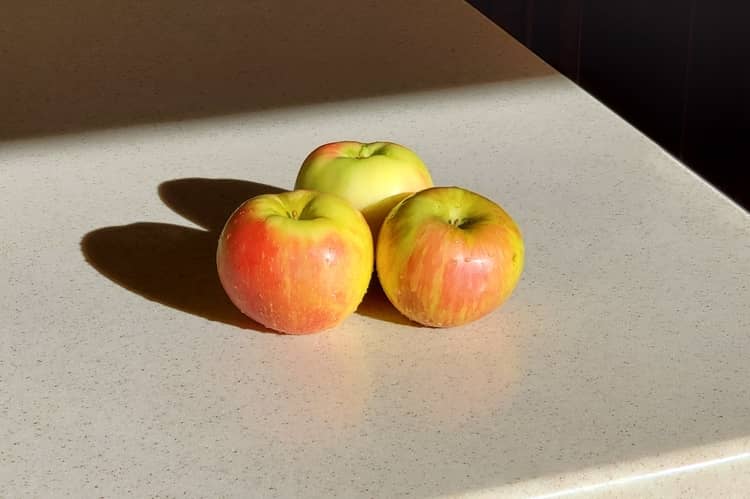 Apples are powerhouses of antioxidants, fiber, and simple sugars. In an age where we are all terrified of sugar in all its forms, simple sugars from things like fresh fruits are a necessary part of a healthy diet.
Apples are powerhouses of antioxidants, fiber, and simple sugars. In an age where we are all terrified of sugar in all its forms, simple sugars from things like fresh fruits are a necessary part of a healthy diet.
So, let’s talk about the benefits of eating apples.
Because of their popularity across the globe and through the spans of time, apples have a tremendous record of study when it comes to health benefits. There aren’t many fruits that have been studied more.
There are antioxidants in apples, coupled with fiber that actually slow the digestion of sugars and help regulate blood sugar.
A research study involving over 38,000 women showed a 28% reduced risk of type 2 diabetes when eating at least 1 apple a day.
There is an enormous amount of research on the effect of apple polyphenols on cancer formation. Apples have phytochemicals that have been shown to kill cancer cells in test tubes. The seeds also contain an arsenic-based compound and while that might scare you the compound is great at depriving cells of the things they need to grow.
The health benefits of apples are expansive and despite all the study, I am sure we don’t even understand the full impact something like a red delicious apple has on our body.
Some people swear by apples for weight loss which could be another benefit to add to the column!
Grow Your Own Apples!
Whether you start a 5-acre apple orchard or just plant a single tree in your backyard, you can grow your own apples. Yet another additional benefit of apples. Additionally, they have been hybridized and built to survive most climates in the nation.
You don’t have to be a scientist to know how to plant an apple tree. If you are worried about when to plant an apple tree, fall and spring are the best times.
If you are worried about where to plant an apple tree, just look for a nice sunny spot that has well-drained soil. Be sure to protect your saplings with some kind of metal fence.
Buy a companion pollinator, or plant a fruit tree guild, if your type of tree requires it. This is simply another tree that can cross-pollinate. This is a necessary process to have the tree produce apples.
My favorites are Honeycrisp, Granny Smith, and Golden Delicious apples. You can even look into heirloom varieties.
Learning how to dehydrate apples starts with sourcing fresh, crisp apples, and what’s better than something from your backyard?
Recommended Books for Your Fruit Garden
How to Prune Fruit Trees, Twentieth Edition The Fruit Gardener’s Bible: A Complete Guide to Growing Fruits and Nuts in the Home Garden
The Fruit Gardener’s Bible: A Complete Guide to Growing Fruits and Nuts in the Home Garden The Holistic Orchard: Tree Fruits and Berries the Biological Way
The Holistic Orchard: Tree Fruits and Berries the Biological Way
8 Simple Reasons Why You Should Dehydrate Apples
Even if you know how to store apples properly, they will go bad eventually. If you know how to dehydrate apples, well, you get much more of a say in how long those apples stick around.
Here are 8 simple reasons to start dehydrating apples.
Healthy Snack
We have already talked about the health benefits of apples but dried apple slices are the perfect snack to reach for when temptation knocks.
Great Dry Food Storage
Even without canning or packing these for the long term, if properly packaged dehydrated apples will have a shelf life of about 6-12 months in your pantry.
Kids Love Them
You can teach kids how to dehydrate apples! They love crunching on them and feel more involved in the food they are eating.
Long Term Food Storage
Storing your dehydrated apples in mylar bags with oxygen absorbers will extend their shelf life even further! They pack up great this way.
Pet Treats
Many types of pets will also benefit from your dried apples. Even those chickens in your backyard chicken coop will appreciate some dehydrated apples from time to time.
Packed Lunches
Breaking free of processed foods in kids’ lunches is hard. Dehydrated apples can help out with that.
Camping/Hiking Food
Whether part of your special camping granola mix or on their own, dehydrated apples are a great food for camping or the outdoors.
Decrease Waste
We are kings of waste in this nation! Instead of throwing those apples on the counter in the trash you could gather them up and learn how to dry apples in the oven.
How to Dehydrate Apples
The process of dehydration is the same no matter what you are dehydrating. You are trying to remove as much moisture as possible without altering the food itself. Don’t brown the apples or cook them under high heat.
Dehydration is a slow process and the same is true when dehydrating apples. However, learning how to make dehydrated apples is very simple if you have the right tools. It’s really a matter of time.
Use the sun, the oven, a solar dehydrator, a home dehydrator, or even some sort of DIY dehydrator that you can dream up on your own! You can even dry apples in a microwave.
Prep Your Apples
Before any dehydrating starts, you are going to need to prep your apples. Most of the work is built into processing the apples.
They need to be peeled, cored, and cut up. You can dice them or cut them into slices. Alternatively, you can do a little of each.
If you aren’t going to act on the dehydration right away you will likely want to place your apples in a bowl with some water and a few squeezes of lemon juice. This will keep them from browning.
Best Methods for Dehydrating Apples
Some methods are better than others when it comes to dehydrating apples. Let’s highlight some of the best and most practical methods for dehydrating apples.
These methods are going to work on Mcintosh, Jonagold, Gala, and Fuji apples. Honestly, it doesn’t matter, they all dehydrate.
Kitchen Oven
One of the best methods to dehydrate apples is to dry them out in the oven. It’s a great way because everyone has access to an oven.
If you have a gas-powered oven, the heat from your pilot light is enough to dehydrate the apples. Simply slide your apples in on baking trays, you could use parchment too, and leave them in the oven overnight. The whole process should take around 15 hours.
If you have an electric oven than you are going to need to set it to the WARM setting. Then you can place your prepped apples, on trays, into the oven. This process will take between 10-12 hours.
Turn the apples once during the process to assure a better (dryer) end product. Moisture can build up between the apples and the pan so when you flip them it gives the heat a chance to do its magic.
It’s nice to use the oven and keep something warm cooking while the air is getting cooler in fall and winter.
Dehydrator
If you are lucky enough to have access to a home food dehydrator then you can keep the oven off and try this method out.
Your processed apples should be cut small enough that they can fit in the many layers of the dehydrator. Using a dehydrator can be much more efficient than an oven. That is certainly a benefit.
NESCO FD-75A, Snackmaster Pro Food Dehydrator, Gray
It will take you about 8 hours to dry out processed apples that have been sliced or diced.
A home food dehydrator is a worthwhile investment if you think that drying and dehydrating is going to be a process that you undertake on a regular basis.
When the apples are dried out and you remove them from the dehydrator, there will be no guesswork involved. The dehydrator does the job best when it comes to dehydration.
The Sun
There are lots of benefits when it comes to drying out food using the sun. The biggest of those is the fact that you don’t need electricity and you don’t need gas or any other fuel. That big ball in the sky is putting off enough heat to dry apples into a dehydrated state.
There are two ways that you can use the sun to dry apples. You are going to use some sort of heat collecting solar dehydrator or you are going to hang your apples in the sun.
Method 1: Solar Dehydrator
In method one, you are going to purchase a hanging drying rack or construct a DIY solar dehydrator.
A DIY solar dehydrator is basically a box with a plastic cover or lid. It can be made of wood or any other material. These boxes hold the sun’s heat and over the course of a full day, they will slowly dehydrate your apples.
Depending on how much sun you get this might even take a couple of days of sun. These DIY boxes will work on other fruits and vegetables, as well.
Method 2: Hanging the Apples
I use a needle and monofilament to thread through larger slices of apple. These apples can be hung in a window or directly outside in the direct sunlight.
This is the slowest method that we are going to discuss. It will take between 3-5 days to dry these apples out.
Beware of bugs if you plan on hanging them outside.
Storing Dehydrated Apples
Dehydrated apples can be stored in a number of ways. From conventional methods like Tupperware to long term canning, dehydrated apples store well.
You can freeze them, too.
How you decide to store your dehydrated apples will play a huge role in how long they last. Your storage method should be based on the number of apples that you are dehydrating and how often you eat them.
There is no point in storing 2 cups of dehydrated apple slices for the long term if your family is going to eat through them in a few days. Keep that in mind.
The most important point of the process is to keep those dehydrated apples dry. You just invested lots of time into drawing the moisture from those apples. Do not store them in the fridge or other moist areas where they could partially hydrate.
How Long Will Dehydrated Apples Last
Dehydrated apples are going to last as long as you make them last!
In other words, if you throw your apples into a Ziploc and store them in the pantry you will get at least a year.
You could vacuum seal those dehydrated apples and you are going to get close to 5 years of shelf life. Look for discoloration and aroma when you open these to check for quality and safety.
By storing your dehydrated apples in mylar bags with oxygen absorbers the shelf life extends even further. Pack those mylar bags up in sealed 5 gallon buckets, for more protection, and you could have dehydrated apples for 15-20 years!
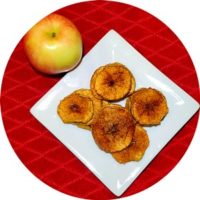
Amazingly Simple Cinnamon Apple Chips Recipe
A super-tasty dried cinnamon apple fruit snack that is easy to make and your kids will love!
Ingredients
- 6 organic Honeycrisp apples
- 1 fresh lemon
- bowl of water
- 1½ tsp ground cinnamon
- ⅓ cup granulated sugar
Instructions
- Mix the sugar and cinnamon together in a small bowl or ramekin.
- Optional: Peel your apples. I keep the peel as it is packed with nutrients (and my kids don't seem to mind!) and saves time.
- Slice the apples into ⅛" or ¼" slices, depending on your thickness preference. (1)
- Fill your bowl with 2-3 cups of water, cut your lemon in half and squeeze all the juicy, lemony goodness into the water (I use the whole lemon, but you can probably get away with using just a half). Throw the rind in there, too!
- Briefly soak the apple slices in the lemon water to prevent them from browning.
- Now for the fun part! Lay your apple slices on parchment paper and generously sprinkle the cinnamon sugar mixture over the apples. According to my kids, there is no such thing as too much!
- Place the apple slices on your dehydrator trays in a single layer with plenty of space for air circulation.
- Set the dehydrator to 135° and allow the apples to dehydrate for 6 hours if you like them chewy and closer to 8 hours if you like them crispy, which is my preference. My wife and kids prefer them chewy, so you can guess who gets the short end of that stick folks! 🙂 (2)
- For short-term storage, you can use Ziploc bags. Use sealed mason jars for medium-term storage. Finally, for extreme long-term storage for us preppers, store in mylar bags with oxygen absorbers.
Notes
(1) To speed up the process you can also use an apple corer & slicer. My preference is big circular slices because some will show a star pattern in the middle where the seeds were! The kids love it! See a theme here? 🙂
(2) If you don't have a food dehydrator at home, you can use your trusty kitchen oven. Line up your apple slices, with a bit of space for air circulation, on trays with parchment paper.
You have a couple of options at this point. You can dehydrate overnight using only the pilot light to dry out your apples. This will take around 15 hours, give or take.
If you are in a hurry, you can set the oven for 200° and bake for 2-4 hours until your desired level of chewiness is achieved. In both cases, don't forget to flip the apples occasionally.
Conclusion
Once you learn how to dehydrate apples, you can add that to your food storage list.
Apples are both highly nutritious and easy to grow if you know the process. You can even learn how to grow apple trees from cuttings!
For the most self-sufficient of you, that means you can grow your own food storage. It doesn’t get much better than that!
The process of dehydration is slow but effective. However, if you incorporate the sun to do your drying, well, you don’t even need fuel.
Your mission is to try out the methods we listed above and decide which works best for you. That will be how you dehydrate apples and many other fruits and veggies.
Enjoy the benefits of eating apples every day with dehydrated slices.




